Red Striped Cotton Gown, 1775-1785
Redcoats and Rebels, OSV, August 2013.
This fabric has been sitting in the stash for years now. When I decided 8 days before Redcoats and Rebels that I needed (i.e. wanted) a new gown, I dug around in the fabric cabinet and unearthed three options. Thanks to input from our Fashionable Frolick Facebook friends, this is the one I ended up with, and I'm so pleased with the outcome!
With our friend B at OSV.
Redcoats and Rebels, OSV, August 2013.
The pattern: The bodice and sleeves of this gown are those draped on me by Ashley at the gown workshop last November. I made a minor alteration to the neckline, however, to square it out ever so slightly to reflect the wider necklines seen in the late 1770s and early 1780s to make it a most fashionable gown for the Rev War period.
Redcoats and Rebels, OSV, August 2013.
Construction details: As these are identical to the pink worsted gown (and every other fitted-back English gown we've done!), I'll just refer you to those previous gown posts if you're interested in reading the in-depth summary!
It's been a while since I've worked with stripes (the last striped gown was the blue and white linen two years ago), so this particular fabric presented a nice "refresher course" in fabric fiddling! The first challenge was deciding the angle of the front chevrons. Extant striped gowns and those appearing in period images display a range of angles; in some examples it is quite severe, while in others, it is so subtle that the stripes create chevrons only at the very top when the bodice widens around bust level. After playing around a bit with the angle, I ended up with a modest chevron, a happy medium that seems to reflect the trend of many of the c.1780ish striped gowns I've encountered in my searches.
The next step was to determine the angle of the back chevrons. This was partially determined already by the front (I'd look silly with severe "V"s at the back, and only subtle ones in the front!), but I angled it ever so slightly a bit more, to give it that necessary waist-defining and narrowing effect so valued by 18th century mantua-makers and their clients!
The outcome of where the front bodice pieces meet the back panel is thus already pre-determined, and based on extant striped gowns, seems not to have been of much concern to mantua-makers of the period. Aiming for perfect chevrons at the sides, in other words, shouldn't be a goal because the front and back logically are the priorities. I just fiddled ever so slightly with the side/back edge of my bodice piece, creating the usual pleasing curve and letting the stripes fall where they will. In the end, it worked out looking quite nice, with the floral stripes sitting next to each other right at the waist and then splaying out a bit as it progresses upwards.
Shoulder strap meeting back panel and sleeve.
Pleating gown skirts is such a pleasure with stripes! Using the floral stripes as my guide, I did tiny 1/4" pleats all the way around. In general (yes, a sweeping generalization, but one nonetheless!), the later you go into the 1770s and 1780s, the smaller the skirt pleats progressively become, so these reflect the very specific period towards which I was aiming with the squared neckline as well.
The fabric: A white medium-weight cotton embroidered in a pattern of red stripes with a tiny floral motif, with the bodice and sleeves lined in ivory linen. I absolutely adore this striped fabric and really wish I'd purchased more when I bought it years ago. As it is, I started out with a one-yard piece and a three-yard piece, and I ended up with just three little scrap bits left. I'd love to have a matching petticoat, so the hunt is now on to find more if I can!
With our friend B at OSV.
Redcoats and Rebels, OSV, August 2013.
Finishing the look: This gown is certainly more posh than anything a camp-following lady should be wearing, but because we were surrounded by a non-military town setting and not the usual lone battlefield, I figured I was perfectly justified in wearing it to Redcoats and Rebels! Although I have a scarlet red cotton petticoat of a similar weight to the gown that was intended to go with it, I opted for the more "common" appearance of the subdued red linen petticoat seen in the previous jacket post, both because it would be around fire and soot, and because it saved me having to remember to bring two petticoats with me! Somehow, despite the very different shades of red of each of those petticoats, they both matched the fabric just fine; the gown's red seems, chameleon-like, to take on whatever shade of red against which it is placed!
With Miss Emily, both of us in fashionable cotton gowns with neat, white aprons!
Redcoats and Rebels, OSV, August 2013.
Walking about town, a sheer striped cotton gauze apron gave the ensemble a nice, clean, and tidy appearance that was further accented by the semi-sheer neck handkerchief that filled in the low, square neckline. A necklace of red coral beads and my new favorite hat completed the outfit and brought it quite nicely into a middle-class impression.
Redcoats and Rebels, OSV, August 2013.
Back in camp, however, I quickly covered that fashionable, delicate white apron by tying a dark blue/ivory/yellow cross-barred linen apron over it to protect it from food preparations, fire, grease, and soot. It also helped tone the outfit down a bit to make it appear more camp-appropriate.
Fashionable white gauze apron covered by the utilitarian dark linen one!
You can see the white one peeking out one side.
Redcoats and Rebels, OSV, August 2013.
Additional photos can be found in this project's flickr set. Clicking on the images here will bring you to flickr and larger picture sizes.

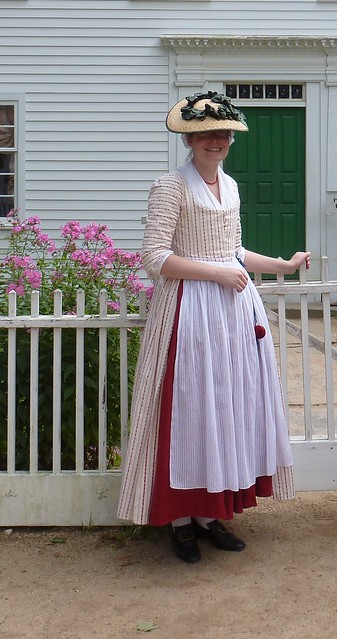

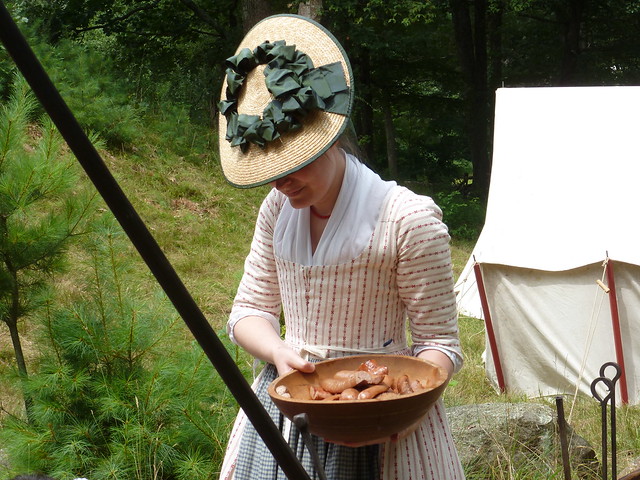
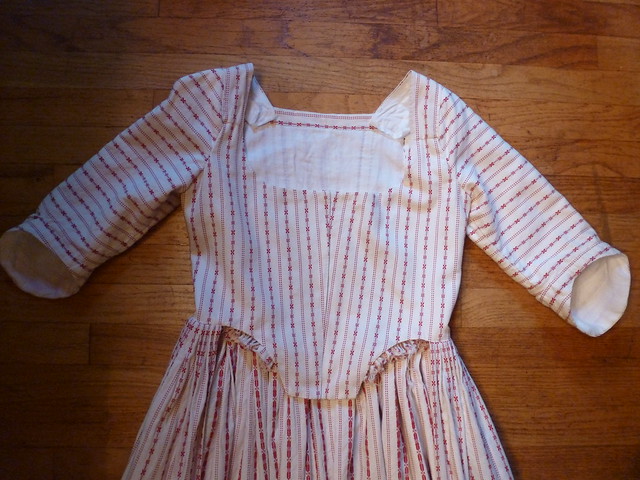
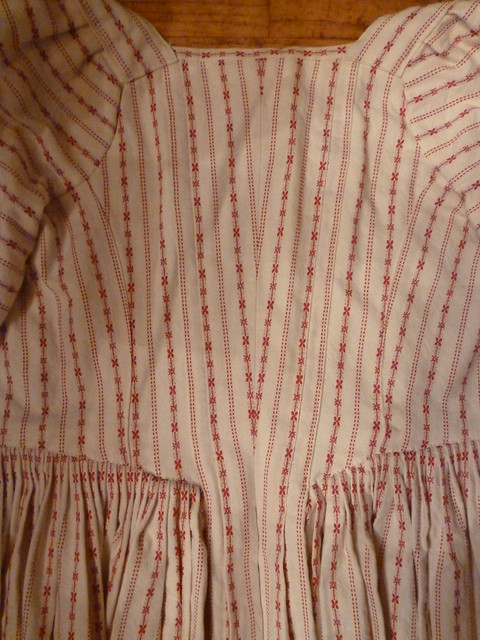
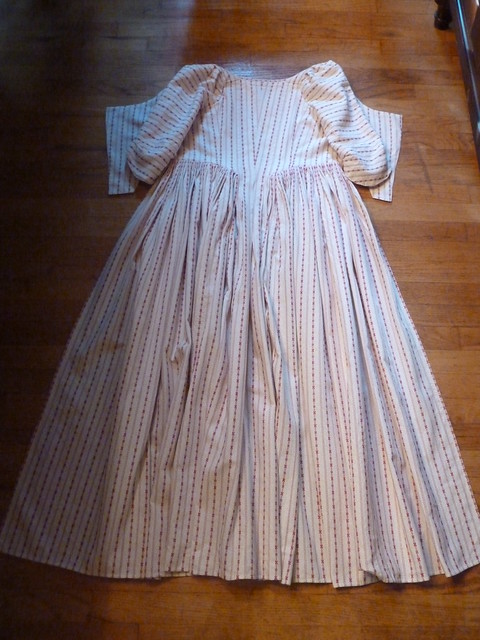
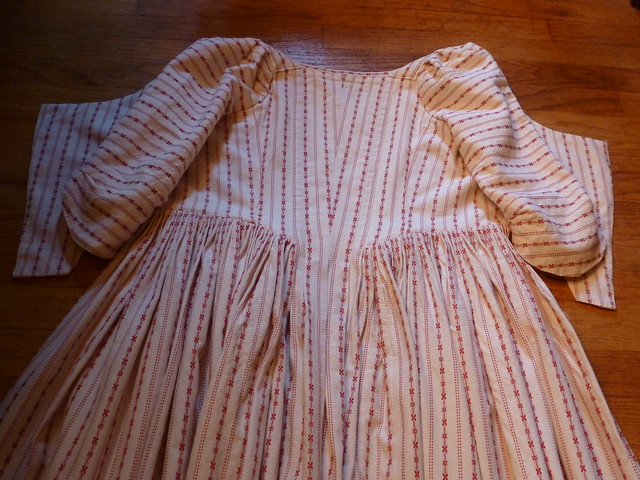

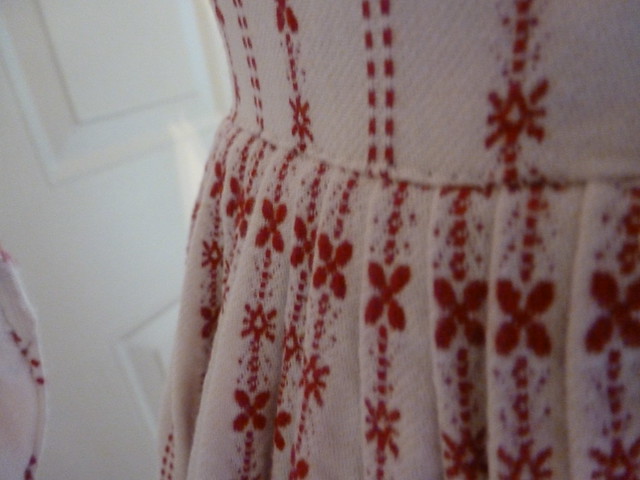


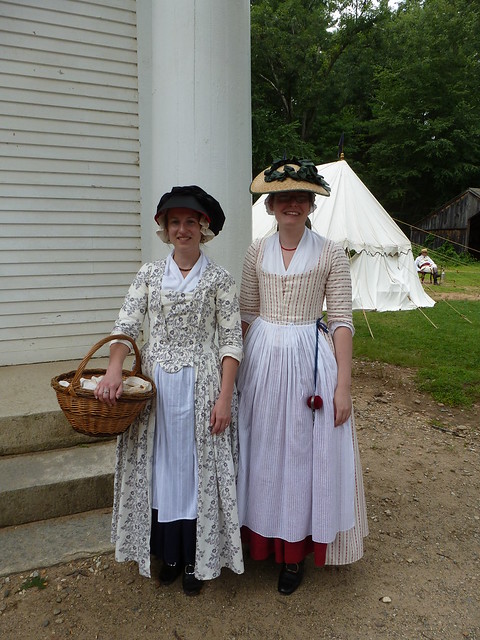
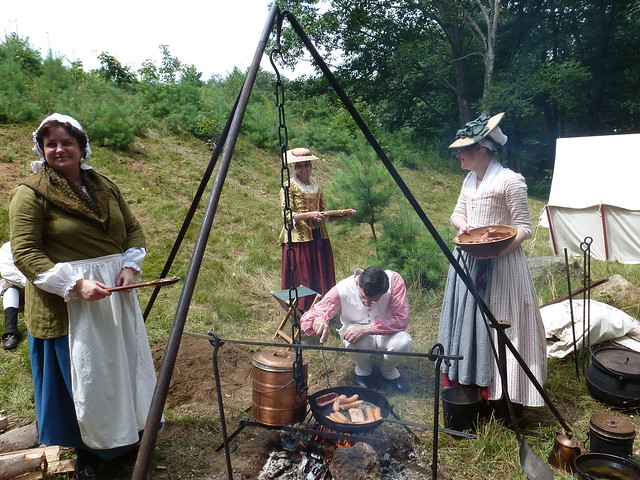
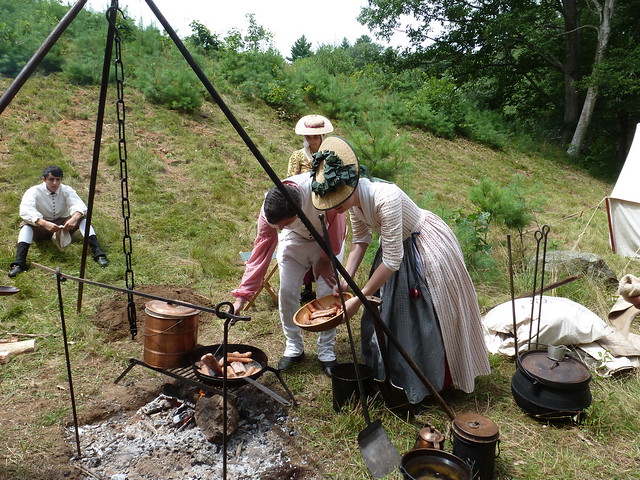
4 comments:
This gown turned out so well! I love how the little flower pattern lines up so neatly at the waist. :)
-Emily
I love the fabric! Very charming :)
Caroline
I'm glad you were able to get it donw so qquickly! I'm sure I'll be seeing it soon!
Laurie
You didn't even brag about my favorite part--the matching of striped from sleeves to back!!! Great job!
Nancy N
Post a Comment